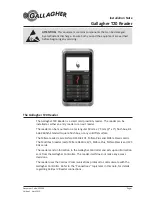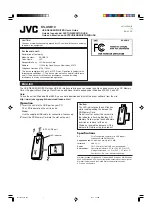
Prosody compact PCI installation guide
16
Appendix B: USA/Canada Approval Details
This section applies only to the 100 Ohm T1 version of the PM4 Line Interface Module.
FCC Connection Requirements
3.15 E1/T1 cPCI card - host interface
A device driver program, running on the host chassis, controls the operation of the E1/T1 cPCI
card.
The driver accesses the card via a control space within an area of shared RAM. This shared area
is a block of memory physically resident on the card that appears as a normal area of memory in
the memory map of the host chassis.
For information on device driver installation and configuration, please refer to the Aculab
publication ‘
Call, Switch and Speech Driver Installation Guide
’. This guide can be downloaded
from the Aculab company web site at
www.aculab.com
.
Systems
Facility Interface Codes (FIC), Service Order Codes (SOC), USOC Jack Codes and Ringer
Equivalence Numbers (REN) are shown in the table below.
Before connecting the card to the public network, you must inform the local telephone company
of this information:
Service Type
SOC
FIC
USOC
REN
T1 6.0N
04DU9-1SN
NA
NAN
ISDN (PRI)
6.0N
04DU9-1SN
NA
NAN
UL requirements
This card has been assessed against UL60950-1 and is a listed accessory component under UL
file number E178354. The Prosody cPCI card should be installed in a UL listed cPCI bus, based
computer system.
Industry Canada Warnings
The Industry Canada Label identifies certified equipment. This certification means that the
equipment meets telecommunications network protective, operational and safety requirements
as prescribed in the appropriate Terminal Equipment Technical Requirements document(s). The
Department does not guarantee the equipment will operate to the users satisfaction.
Before installing this equipment, users should ensure that it is permissible to be connected to the
facilities of the local Telecommunications Company. The equipment must also be installed using
an acceptable method of connection. The customer should be aware that compliance with the
above conditions might not prevent degradation of service in some situations.
A representative designated by the supplier should co-ordinate repairs to certified equipment.
Any repairs or alterations made by the user to this equipment, or equipment malfunctions, may
give the telecommunications company cause to request the user to disconnect the equipment.
Users should ensure for their own protection that the electrical ground connections of the power
utility, telephone lines and internal metallic water pipe system, if present, are connected
together. This precaution may be particularly important in rural areas.
WARNING
USERS SHOULD NOT ATTEMPT TO MAKE SUCH CONNECTIONS THEMSELVES, BUT SHOULD CONTACT THE APPROPRIATE ELECTRIC
INSPECTION AUTHORITY, OR ELECTRICIAN, AS APPROPRIATE.
















































